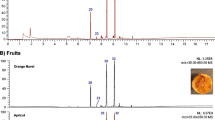Abstract
The effect of fly or fruit treatments on quality and/or quantity of host-marking pheromone (HMP) trail substance released by apple maggot flies (Rhagoletis pomonella) following oviposition was evaluated. Among flies, considerable variation existed in the amount of HMP substance deposited, but overall, the amount of substance released on successively offered fruit (over a day or a week) did not change appreciably. Fly diet did not influence pheromone activity. Older flies (28 days) or smaller flies released less or less active HMP trail substance than younger flies (14 days) or larger flies. Females deposited a similar amount of trail substance on large (18–19 mm diam.) or HMP-marked fruit as on small (12–13 mm) or unmarked fruit. Starvation reduced the amount of measurable trail substance deposited but resulted in a more active HMP deposition. Discrepancy between trail measurement and behavioral bioassay results for the starvation treatment indicated that trail measurement results may be misleading under conditions that reduce gut contents of the fly.
Similar content being viewed by others
References
Alcock, J. 1979. Animal Behavior: An Evolutionary Approach. Sinauer Assoc., Sunderland, Massachusetts.
Averill, A.L., andProkopy, R.J. 1987. Intraspecific competition in the tephritid fruit flyRhagoletis pomonella.Ecology 68:878–886.
Baker, T.C., andCardé, R.T. 1979. Endogenous and exogenous factors affecting periodicities of female calling and male sex pheromone response inGrapholitha molesta (Busck).J. Insect Physiol. 25:934–950.
Bjostad, L.B., Gaston, B., andShorey, H.H. 1980. Temporal pattern of sex pheromone release by femaleTrichoplusia ni.J. Insect Physiol. 26:493–498.
Boush, G.M., Baerwald, R.J., andMiyazaki, S. 1969. Development of a chemically defined diet for adults of the apple maggot based on amino acid analysis of honeydew.Ann. Entomol. Soc. Am. 62:19–21.
Byers, J.A. 1983. Influence of sex, maturity and host substances on pheromones in the guts of the bark beetles,Ips paraconfusus andDendroctonus brevicomis.J. Insect Physiol. 29(1):5–13.
Cameron, P.J., andMorrison, F.O. 1974. Sampling methods for estimating the abundance and distribution of all life stages of the apple maggot,Rhagoletis pomonella (Diptera: Tephritidae).Can. Entomol. 106:1025–1034.
Chapman, R.F. 1969. The Insects. Structure and Function. Elsevier North Holland, New York.
Dean, R.W., andChapman, P.J. 1973. Bionomics of the apple maggot in eastern New York.Search Agric. 3(10):64 pp.
Fitzgerald, T.D. andPeterson, S.C. 1983. Elective recruitment by the eastern tent caterpillar (Malacosoma americanum).Anim. Behav. 31:417–423.
Hammack, L., Ma, M., andBurkholder, W.E. 1976. Sex pheromone releasing behavior of the dermestid beetle,Trogoderma glabrum.J. Insect Physiol. 22:555–561.
Hantgartner, W. 1969a. Control of pheromone quantity in odour trails of the antAcanthomyops interjectus May.Experientia 26(6):664–665.
Hantgartner, W. 1969b. Structure and variability of the individual odor trail inSolenopsis geminata Fabr. (Hymenoptera: Formicidae).Z. Vergl. Physiol. 62:111–120.
Hardee, D.D. 1970. Pheromone production by male boll weevils as affected by food and host factors.Contrib. Boyce Thompson Inst. 24:315.
Hendry, L.B. 1976. Insect pheromones: Diet related.Science 192:143–145.
Mazomenos, B.E. 1984. Effect of age and mating on pheromone production in the female olive fruit fly,Dacus oleae (Gmel.).J. Insect Physiol. 30(10):765–769.
Miller, J.R., Baker, T.C., Cardé, R.T., andRoelofs, W.L. 1976. Reinvestigation of oak leaf roller sex pheromone components and the hypothesis that they vary with diet.Science 192:140–143.
Neilson, W.T.A., andWood, F.A. 1966. Natural source of food of the apple maggot.J. Econ. Entomol. 54(4):997–998.
Nordlund, D.A., andBrady, U.E. 1974. The calling behavior of femalePlodia interpunctella (Hubner) under two light regimes.Environ. Entomol. 3:793–796.
Prokopy, R.J. 1972. Evidence for a marking pheromone deterring repeated oviposition in apple maggot flies.Environ. Entomol. 1(3):326–332.
Prokopy, R.J. 1981. Oviposition-deterring pheromone system of apple maggot flies. pp. 477–494,in E.K. Mitchell (ed.). Management of Insect Pests with Semiochemicals. Plenum Press, New York.
Prokopy, R.J., andBoller, E.F. 1970. Artificial egging system for the European cherry fruit fly.J. Econ. Entomol. 63:1413–1417.
Prokopy, R.J., Malavasi, A., andMargante, J.S. 1982a. Oviposition-deterring pheromone inAnastrepha fraterculus.J. Chem. Ecol. 8:763–771.
Prokopy, R.J., Averill, A.L., Cooley, S.S., andRoitberg, C.A. 1982b. Variation in host acceptance pattern in apple maggot flies, pp. 123–129,in J.H. Visser and A.K. Minks (eds.). Proceedings 5th International Symposium, Insect-Plant Relationships. Wageningen, Pudoc.
Prokopy, R.J., Averill, A.L., Bardinelli, C.M., Bowdan, E.S., Cooley, S.S., Crnjar, R.M., Dundulis, E.A., Roitberg, C.A., Spatcher, P.J., Tumlinson, J.H., andWeeks, B.L. 1982c. Site of production of an oviposition-deterring pheromone component inRhagoletis pomonella flies.J. Insect Physiol. 28(1):1–10.
Quiring, D.T., andMcNeil, J.N. 1984. Intraspecific larval competition reduces efficacy of oviposition-deterring pheromone in the alfalfa blotch leafminer,Agromyza frontella (Diptera: Agromyzidae).Environ. Entomol. 13:675–678.
Sanders, C.J., andLucuik, G.S. 1972. Factors affecting calling by female eastern spruce budworm,Choristoneura fumiferana (Lepidoptera: Tortricidae).Can. Entomol. 104:1751–1762.
Webster, R.P., Stoffolano, J.G., andProkopy, R.J. 1979. Long-term intake of protein and sucrose in relation to reproductive behavior in wild and laboratory culturedRhagoletis pomonella.Ann. Entomol. Soc. Am. 72:41–46.
Wiygul, G., andWright, J.E. 1983. Sex pheromone production in male boll weevils fed cotton squares and laboratory diet.Entomol. Exp. Appl. 34:333–335.
Zimmerman, M. 1980. Selective deposition of an oviposition-deterring pheromone byHylemya.Environ. Entomol. 9:321–324.
Zimmerman, M. 1982. Facultative deposition of an oviposition-deterring pheromone byHylemya.Environ. Entomol. 11(2):519–522.
Author information
Authors and Affiliations
Rights and permissions
About this article
Cite this article
Averill1, A.L., Prokopy, R.J. Factors influencing release of hostmarking pheromone byRhagoletis pomonella flies. J Chem Ecol 14, 95–111 (1988). https://doi.org/10.1007/BF01022534
Received:
Accepted:
Issue Date:
DOI: https://doi.org/10.1007/BF01022534




